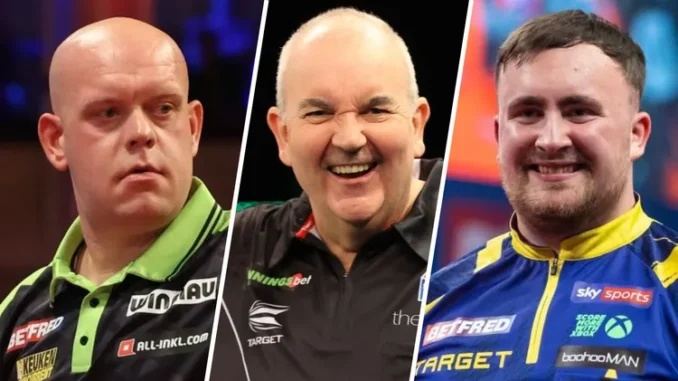
In the electrifying world of professional darts, where three-figure averages have become a hallmark of excellence, one performance stands alone as the pinnacle of precision: Colin Osborne’s jaw-dropping 143.14 three-dart average in a UK Open Qualifier. This staggering feat, achieved in a non-televised match, remains the highest average ever recorded in the Professional Darts Corporation (PDC), surpassing even the legendary exploits of Phil Taylor, Michael van Gerwen, and Luke Littler. Far from the glitz of televised arenas, Osborne’s performance in a pub setting redefined what’s possible on the oche, cementing his place in darts history.
The stage was a modest one—a UK Open Qualifier, where players battle for a coveted spot in one of the PDC’s major tournaments. Osborne, a 50-year-old Englishman known as ‘The Wizard,’ was a seasoned competitor, having reached the 2007 UK Open final and won the 2009 Championship League. Facing an unnamed opponent, he delivered a masterclass, winning 4–0 with legs of 11, 11, 9, and 11 darts. “Colin won 4–0 with legs of 11, 11, 9, and 11 darts — phenomenal stuff,” recalled Paul Nicholson, a former major winner who investigated the feat’s authenticity. Without the digital precision of DartConnect, which wasn’t in use at the time, witnesses, including the tournament director, confirmed the score, ensuring its place in the record books.
What makes Osborne’s 143.14 average so extraordinary is its context. Unlike televised matches, where players perform under intense scrutiny, floor tournaments like qualifiers often see players unleash raw, uninhibited brilliance in shorter formats. Osborne’s average, achieved in a best-of-seven-leg match, required near-perfect scoring and finishing. To put it in perspective, a 143.14 average means he scored roughly 501 points in just 10.5 darts per leg—a feat that demands relentless treble-hitting and pinpoint doubles. “It’s a shame we didn’t have DartConnect back then,” Nicholson lamented, noting that his own unverified 121 average against Colin Lloyd paled in comparison. Osborne’s performance, though not captured on camera, has become a darting legend, whispered about in pubs and halls where players dream of such heights.
While Osborne’s record holds the top spot, other players have come close in non-televised events. The late Kyle Anderson, a beloved Australian darter, posted a 134.84 average at a 2015 Players Championship against Terry Jenkins, a mark that remains the second-highest in PDC history. “Kyle’s average was incredible,” a fan remarked on social media, reflecting the awe inspired by such performances. Anderson’s untimely passing in 2021 added poignancy to his legacy, with the Australian Darts Masters trophy now named in his honor. These non-televised records highlight the raw talent thriving away from the spotlight, where players like Osborne and Anderson pushed the boundaries of the sport.
On the televised stage, the highest averages are dominated by familiar names, though none have touched Osborne’s mark. Michael van Gerwen’s 123.40 in a 2016 Premier League match against Michael Smith remains the benchmark for televised matches, followed closely by Kim Huybrechts’ 121.97 in a 2017 World Cup quarter-final against Paul Lim. Peter Wright’s 119.50 against Adrian Lewis in 2017 rounds out the top three. “When you run into a 115 average, there’s not much you can do,” Luke Humphries said after facing Littler’s brilliance, a sentiment that underscores the challenge of matching such scoring power. Yet, Osborne’s 143.14, achieved in the shadows of a pub, dwarfs even these televised heroics, a testament to the untapped potential in floor tournaments.
Osborne’s career, though not as decorated as Taylor’s 16 world titles or van Gerwen’s three, was marked by consistency and flair. His 2007 UK Open run saw him defeat van Gerwen and Raymond van Barneveld before falling to Vincent van der Voort in the final. His 2009 Championship League triumph further showcased his ability to compete with the elite. Yet, it’s the 143.14 average that defines his legacy, a record that has withstood the test of time despite the sport’s evolution. Advances in equipment, like thinner dartboard wires, and increased professionalism have pushed averages higher, but Osborne’s mark remains untouched. “The overall standard in the game has arguably never been healthier,” noted a darts commentator, suggesting that young players on the PDC Development Tour could one day challenge such records.
As darts continues to grow, fueled by rising prize money and global interest, Osborne’s feat serves as both an inspiration and a challenge. The PDC’s £25 million prize pool in 2026 and the £1 million on offer for the 2025/26 World Championship winner reflect the sport’s financial boom. Yet, for every Littler or Humphries chasing televised glory, Osborne’s record reminds us of the magic that can unfold in a quiet pub, where a single performance can etch a name into darting immortality. His 143.14 average stands as a beacon, daring the next generation to aim higher and throw harder.
Leave a Reply